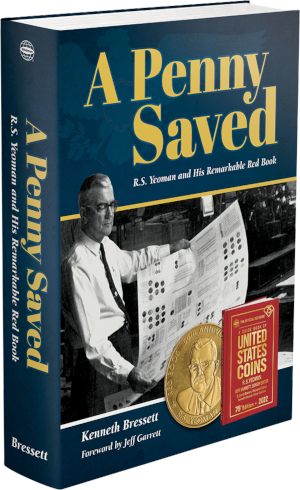Kenneth Bressett’s memoir A Penny Saved: R.S. Yeoman and His Remarkable Red Book celebrates the life of his mentor, hobby legend Richard S. Yeo (known as R.S. Yeoman), and the longevity of the Guide Book of United States Coins (the “Red Book”), first published in 1946. The 352-page hardcover volume is available from bookstores and hobby shops and online (including at Whitman.com). This excerpt is from chapter 5, wherein Bressett shares a number of Yeoman’s writings. It was first published in the February–March 1964 issue of the Whitman Coin Supply Merchandiser. Yeoman talks about the importance of coin shows, the camaraderie they foster, and how to balance their objectives. He put these thoughts on paper 60 years ago—but they could have been written with equal wisdom today.
Whatever observation we make about the trend of coin collecting, the desire to assemble in large groups is clearly the most evident. Any week of the year, with a few obvious exceptions, there are one to ten coin shows in as many communities throughout the United States and Canada. It is a good trend, and those of us who supply the necessary accessories for arranging, protecting, and pricing coins, should encourage this kind of togetherness to the utmost.
The primary objective of the convention has been and probably will continue to be the selling and buying of coins. These gatherings are basically bourses, and most dealers derive an added benefit from making contacts with new and old customers. The sale of a coin folder or Blue Book to a novice collector is often the start of a long-term dealer-client association.
The future of the coin show or convention, however, rests on more than the bourse, and it is encouraging to see how some local club sponsors are keeping a happy balance between the dealer’s bourse, the auction, and the educational features. The show chairman is on the right track when he emphasizes exhibits and announces well in advance that handsome trophies or plaques will go to the winners. He knows that newcomers to the numismatic ranks are quickly brought into the show when the local newspaper, radio, and TV announces a free exhibit of rare coins.
We have noticed that the best attendance comes to those coin shows that have a modest or free registration, accessible display room, cordial committee members to answer questions, and a place to rest when the feet start to tire. One feature in particular has been offered by only a few conventions, and that is a special educational forum. Sometimes a panel of two to four well-informed individuals can do more to further the hobby than all the coin investment plans ever devised. There ought to be more of this kind of thing.
Our hobby can be torn apart very thoroughly if the profit motive continues to be over-emphasized to the exclusion of educational features. Competitive displays, authoritative lectures, mind-stimulating forums, and displays of available numismatic literature are convention attractions that can strengthen and perpetuate the ranks of the coin collecting fraternity. Let us have both school and marketplace, but in the right proportion. Perhaps we can plan our conventions this year with more emphasis on profit of the mind.

